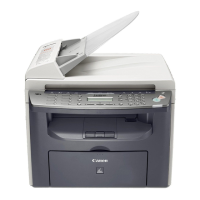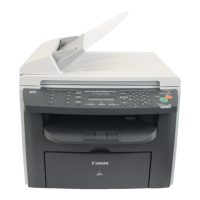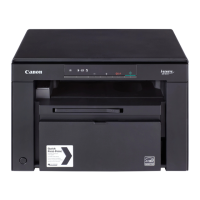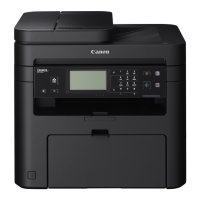
Do you have a question about the Canon i-SENSYS MF4350d and is the answer not in the manual?
| Print Technology | Laser |
|---|---|
| Duplex Printing | Yes |
| Copy Resolution | Up to 600 x 600 dpi |
| Fax Modem Speed | 33.6 Kbps |
| Paper Capacity | 250 sheets |
| Connectivity | USB 2.0 |
| First Page Out | Less than 9 seconds |
| Scanning | Yes |
| Maximum Scan Resolution | 9600 x 9600 dpi |
| Input Colour Depth | 24-bit |
| Output Colour Depth | 24-bit |
| Standard Output Capacity | 100 sheets |
| Paper Size (Max) | A4 |
| Internal Memory | 64 MB |
| Functions | Print, Copy, Scan, Fax |
| Fax Transmission Speed | 3 seconds per page |
| Operating Systems Supported | Windows, Mac OS |
| Print Speed | 22 ppm |
| Copy Speed | 22 cpm |
| Scan Type | Flatbed |
| Scan Resolution | 600 x 600 dpi |
Details the overall specifications of the MF4300 series printer.
Identifies and labels the external components of the printer body.
Outlines critical safety precautions for operating and servicing the machine.
Lists detailed technical specifications for the host machine and ADF/DADF.
Describes the operational ranges for scanning and recording functions.
Explains the functional configuration of the host machine's systems.
Details the arrangement of the host machine's functional blocks.
Outlines the sequence of operations for the reader and engine from power-on.
Describes the intervals and operations during the machine's basic sequence.
Provides basic construction details for the document exposure system.
Lists specifications, controls, and functions for document exposure.
Identifies the primary components of the document exposure system.
Details the steps for replacing key parts within the exposure system.
Covers the procedure for removing and replacing the scanner unit.
Explains how to prepare for and remove the reader motor.
Details the procedure for removing the contact sensor.
Describes the fundamental operation of the original feeding system.
Explains the basic operation of the Automatic Document Feeder (ADF).
Explains the basic operation of the Duplex Automatic Document Feeder (DADF).
Details the methods used for detecting original presence and end.
Covers jam detection scenarios and how to release jammed paper.
Details parts and procedures related to ADF and DADF.
Explains how to remove the ADF and DADF pickup rollers.
Provides steps for preparing and removing the ADF motor.
Details the procedure for removing ADF and DADF separation pads.
Provides an overview and configuration of the laser scanner assembly.
Explains the control mechanisms for laser activation timing.
Details the Auto Photoelectric Current Control (APC) for laser intensity.
Covers the control of the laser scanner motor speed and fault detection.
Outlines the procedure for replacing the laser scanner unit.
Details preparation and removal steps for the laser scanner unit.
Describes the overall configuration of the image forming system.
Details the components of the image forming system.
Explains the step-by-step process of image formation for printing.
Covers the driving and control of the high-voltage system for image formation.
Explains the toner level detection mechanism.
Outlines the procedure for replacing the transfer charging roller.
Details the steps for removing the transfer charging roller.
Provides an overview of the pickup and feeding system components.
Details additional control mechanisms for paper pickup and feeding.
Explains how jams are detected in the paper path.
Provides an outline of the jam detection logic and sensors.
Describes pickup and delivery delay jam conditions.
Explains stationary jam detection scenarios.
Covers various other types of jams like door open and wrapping.
Describes the overview and operation of the duplex unit.
Outlines procedures for replacing parts in the pickup/feed system.
Details preparation and removal steps for the main motor.
Explains how to prepare for and remove the separation pad.
Details the procedure for removing the pickup roller.
Provides an overview of the fixing system's configuration.
Lists specifications, controls, and functions for the fixing method.
Describes the components and operation of the fixing unit.
Details control mechanisms for the fixing unit's temperature.
Explains temperature control modes for the fixing heater.
Outlines the three protection functions for the fixing heater.
Covers procedures for replacing the fixing unit and film unit.
Details preparation and removal of the fixing assembly.
Explains how to prepare for and remove the fixing film unit.
Describes the control panel's components and operation.
Provides an outline of the machine's control panel structure.
Details the power supply route and protection functions.
Illustrates the flow of power supply within the machine.
Explains the protection functions for the power supply PCB.
Covers the procedure for replacing external covers and internal components.
Details the steps for removing the front cover.
Explains how to prepare for and remove the rear cover.
Details the procedure for removing the right cover.
Explains how to remove the left cover.
Details the preparation and removal of the upper cover.
Covers preparation and removal of the printer cover (cartridge cover).
Details the removal of the control panel unit.
Explains preparation, removal, and actions for replacing the SCNT PCB.
Covers preparation and removal of the DCNT PCB.
Details preparation and removal of the power supply PCB.
Explains preparation and removal of the high voltage PCB.
States that there are no periodically replaced parts for this machine.
Indicates that there are no specific periodical service items.
Lists items that require cleaning and their timing.
Specifies cleaning items and responsible parties for different areas.
Provides instructions for cleaning external covers.
Details the method for cleaning components within the reader unit.
Explains the procedure for cleaning the pressure roller.
Introduces basic adjustments for print and reading parameters.
Details how to adjust paper margins for various scanning and copy functions.
Explains how to adjust scanning start positions for different modes.
Describes how to adjust print recording start positions for various paper paths.
Provides an overview of electrical components like motors, sensors, and PCBs.
Lists the solenoids and motors used in the ADF and DADF.
Identifies solenoids and motors with their symbolic names and functions.
Lists the sensors used in the machine for detecting paper and other states.
Identifies sensors with their symbolic names and functions.
Lists the Printed Circuit Boards (PCBs) used in the machine.
Identifies PCBs with their symbolic names and functions.
Provides an overview of error codes and their purpose in diagnosing faults.
Explains how error codes are indicated and used for troubleshooting.
Lists system, scanner, printer, and communication error codes with causes and remedies.
Provides an overview of the Service Mode and its functions.
Describes how to set service data items like formatting and speed settings.
Details the procedure for accessing the Service Mode.
Shows the structure of the Service Data Menu with country/region options.
Explains the Soft Switch Settings (SSSW) and their functions.
Defines how Soft Switches are structured and interpreted.
Outlines the Test Mode, including print test patterns and hardware tests.
Explains the purpose and operation of the static test mode.
Shows how to navigate and operate the test mode menus.
Describes faculty tests like print pattern, sensor, and key tests.
Details how to print test patterns for printer and scanner checks.
Explains how to check the status of each sensor using the Sensor Test.
Describes how to test the functionality of the operation panel keys.
Lists essential service tools used for maintenance.
Provides a table of solvents and lubricants for cleaning and maintenance.











